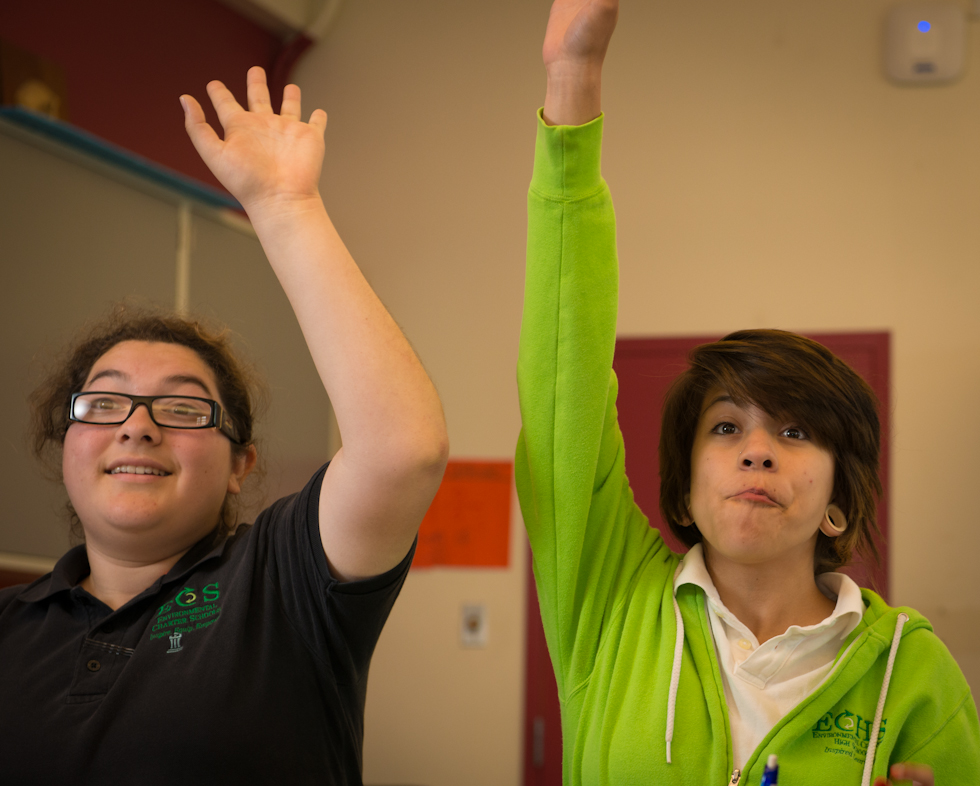As you may have heard in the news, the California State Board of Education has adopted the Common Core State Standards (CCSS) for English Language Arts and Math. What may surprise you is that these standards were actually adopted in 2010 and that ECS has been working with them since then.
Just last week the State Board also adopted the Next Generation Science Standards.
The new standards focus on covering fewer topics in greater depth calling for students to read, listen and think critically – the goal being that students acquire the knowledge and master the skills required to be prepared for college and the workforce. An expert explains: “These new standards recognize that the premium in today’s world is not merely on students’ acquiring information, but on their being able to analyze, synthesize, and apply what they’ve learned to address new problems, design solutions, collaborate effectively, and communicate persuasively.” (from Linda Darling-Hammond via Washingtonpost.com)
On first look at samples of the testing tasks for the new standards, ECS teachers were encouraged. “This is what we have already been doing at ECS” says Amy Frame, our ECS Director of Instruction & Curriculum.
ECS was founded on a series of research-based best practices, one of which is to select a few standards and teach them in depth through authentic projects. The new standards and assessments are finally catching up with our best practices.
What has changed now is that the standards themselves recognize the need for depth over breadth and that the new assessments are more complex and more like tasks with which our students are familiar. Frame concluded, “As our kids and teachers transition to the new system, we expect it will be easier for them than for their peers at other schools. We expect they’ll be more successful on the new tests. ECS strives to continue modeling innovative education and being a resource to other schools aligning themselves with the new national vision.”
We believe the Common Core Standards are a vehicle for the kind of positive, long and lasting change we wish to see in the world. By welcoming and working with the new standards we will continue on our mission: To equip all students with the knowledge and skills to graduate from college, to inspire them to discover their own sense of purpose, and to empower them to become quality stewards of their community and world.

In addition to some carefully constructed multiple choice items, the new tests will have open-ended performance tasks which require students to interpret and analyze information in multiple forms from various sources, and apply this understanding in real world contexts.
English Language Arts (Across Grade Levels): Students must demonstrate that they can read closely and analytically to comprehend a range of increasingly complex literary and informational texts. They are given an excerpt of text, asked analytical questions and required to use details from the text to support their answers.
Math – Communicating Reasoning (Grade 5): Five swimmers compete in the 50-meter race. The finish time for each swimmer is shown in the video. [5 times are shown to .00 or hundredths of a second] Explain how the results of the race would change if the race used a clock that rounded to the nearest tenth.
Math – Problem Solving (High School): A circle has its center at (6, 7) and goes through the point (1, 4). A second circle is tangent to the first circle at the point (1, 4) and has the same area. What are the coordinates for the center of the second circle? Show your work or explain how you found your answer.
- Our Middle Schools have completely switched to the new standards and have already spent 1.5 years developing curriculum and assessments aligned with the CCSS.
- Interdisciplinary instruction: we create lessons that integrate subjects as a yearlong practice for teachers.
- Grade level teams work together to create content-rich projects around essential questions and big understandings.
Is there really such a thing as independence?
How does recognizing patterns help us survive?
How do I affect the systems around me?
- Middle School projects embed standards in historical settings to spark kids’ imaginations and develop their curiosity about other cultures.
Math reasoning, critical reasoning, writing skills, and historical content are used in an ancient civilizations project. Through a trade simulation called “The Silk Road”, 6th graders create business ideas, calculate taxes, fees, profits, and design solutions for natural hazards they may encounter on their business journeys. They use writing and persuasion skills to seek “investors” and justify a return on investment, also displaying their mathematical reasoning.
- While the state’s testing and accountability system are in flux, we have refined our own performance assessments and scoring process so that teachers, parents, and students can be sure where each student stands in regard to each standard.
- ECMS-G fully switched to the new standards last year, and has aligned all of its assessments, report cards, and instruction in accordance to them.
- Both Middle Schools have worked to realign 6th, 7th, and 8th grade math courses to the new standards. Less emphasis is now placed on rushing kids into algebra, but instead building a solid foundation in all the math domains.
- Our students take a computer adaptive test multiple times per year and will not be phased by the technical aspects of the new assessments.
- ECHS has adjusted its Learning Targets this year and is now aligning its assessments with CCSS.
- To prepare kids for careers, programs take the academic standards and extend them by taking lessons learned out into the community.
- Intersession – Grade level teams work together to create content-rich projects around essential questions and big understandings.
- Senior Thesis is a required project for graduation, similar to a thesis or dissertation for a college student.
- ECHS has forged ahead in creating new Integrated Math sequences (both regular and accelerated versions) which combine content from algebra, statistics, geometry, and modeling.
- While the state’s testing and accountability system are in flux, we have refined our own performance assessments and scoring process so that teachers, parents, and students can be sure where each student stands in regard to each standard.
- Our students take a computer adaptive test multiple times per year and will not be phased by the technical aspects of the new assessments.
- Students will continue to graduate college and career ready, knowing both content and how to critically interact with the content.
- We predict that our students will do well on new tests.
- We expect that ECS students will far surpass their peers – as they are used to multi-step, multi-day tasks with more than one ‘correct’ answer.
- Our students will be admitted to top universities due to their higher-level critical and reasoning skills.
- There will be increased demand to share our curriculum.
- We will share our best practices with our colleagues.
- ECS will continue to be a model and leader in innovative education.

EXAMPLE:
10th graders study changes to the L.A. Ecosystem and collect local biodiversity data and build a multi-media natural history museum display that travels to local elementary and middle schools.
What is quality of life? (9th grade)
Why does my community need me? (12th grade)
Powers of persuasion through words and data can make you a valuable member of your community (9th grade)
Learn more
As with any important issue we urge you to further educate yourself on this topic. We have added a list of articles and videos, we’ve found useful on this topic here:
— DENNIS VAN ROEKEL, Why the Common Core Could Bring the End of One-Size-Fits-All Learning
–PATTE BARTH, The Common Core Standards: Truths, Untruths and Ambiguities
“They say the new standards are modeled on the teaching strategies of countries, especially in Asia, that perform better on international comparisons. ”
“The state (New York) has prepared teachers by holding workshops and posting a website of videos and documents describing the changing expectations.”
–KENNETH CHANG, New York Times











